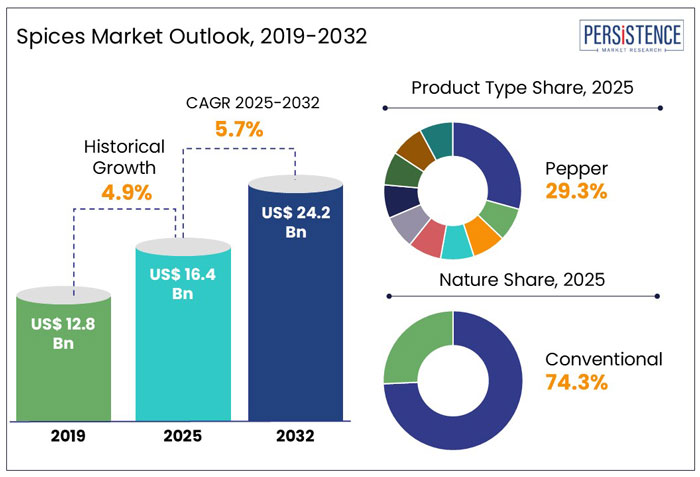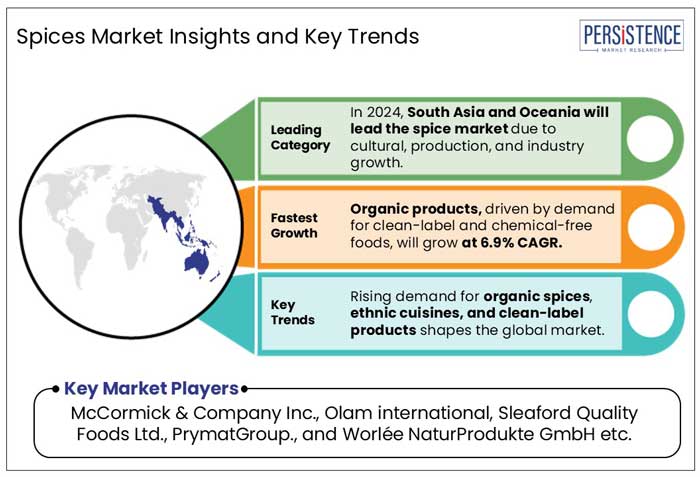Industry: Food and Beverages
Published Date: March-2025
Format: PPT*, PDF, EXCEL
Delivery Timelines: Contact Sales
Number of Pages: 475
Report ID: PMRREP32805
According to Persistence Market Research the Global Spices Market is estimated to increase from US$ 16.4 Bn in 2025 to US$ 24.2 Bn by 2032. The market is projected to record a CAGR of 5.7% during the forecast period from 2025 to 2032.

Key Highlights of the Market
|
Market Attributes |
Key Insights |
|
Global Spices Market Size (2025E) |
US$ 16.4 Bn |
|
Projected Market Value (2032F) |
US$ 24.2 Bn |
|
North America Market Growth Rate (CAGR 2025 to 2032) |
5.7% |
|
Historical Market Growth Rate (CAGR 2019 to 2023) |
4.9% |
|
Country |
CAGR through 2032 |
|
U.S. |
~5.9% |
In North America, the U.S. spices market is growing rapidly at a CAGR of 5.9%, and it accounts for 84.5% of the region's market share. This is owing to a surge of South Asian immigrants into the region.
Spice demand is projected to rise as a result of their influence on local food platters. As a result, an increasing number of Indian and Chinese restaurants are offering ethnic cuisines with a variety of ingredients. It also encourages residents to utilize certain spices in their dishes.
India Leading the South Asia Spices Market
|
Country |
CAGR through 2032 |
|
India |
~6.9% |
India spices market accounts for around 79% of the South Asia spices share. This is primarily because spices are a fundamental part of every household's cooking in the country. The demand for spices is expected to rise further due to their significant influence on local and international food platters.
This robust production supports the increasing demand for spices globally, as Indian and Chinese restaurants continue to expand, offering ethnic cuisines with a diverse range of ingredients. Additionally, the growing popularity of traditional Indian dishes among residents in various countries is encouraging the increased use of specific spices in home-cooked meals, further propelling the global demand for spices.
|
Category |
CAGR through 2032 |
|
By Nature - Organic Spices |
6.8% |
“Natural Food Trend Bodes Well for Organic Spices & Herbs”
Consumers today value their health above everything, and they are willing to spend extra on organic food because of its health benefits.
Organic spices and herbs are becoming more popular as customers become increasingly aware of the toxic chemicals used in agricultural practices. The health benefits of organic products are the most significant reason driving the organic products market, which, in turn, is driving demand for organic spices and herbs.
Increasing government measures to promote natural foods since organic farming helps maintain environmental health by lowering pollution levels, has an impact on the growth of organic spices.
The global spices market is experiencing significant growth driven by evolving consumer preferences for authentic flavors, natural ingredients, and ethnic cuisines. Increasing urbanization, rising disposable incomes, and growing demand for ready-to-cook and convenience food products have further fueled the demand for spices worldwide.
Consumers are becoming more health-conscious, resulting in a growing inclination toward natural, organic, and minimally processed spices, boosting the demand for clean-label products. Additionally, the increasing popularity of international cuisines, such as Indian, Mexican, and Thai, has expanded spice consumption in various regions.
Food manufacturers are also introducing innovative spice blends and exotic seasonings to cater to changing consumer tastes, further stimulating market growth. Moreover, the growing number of food service outlets, including fast-food chains and casual dining restaurants, is increasing the usage of spices in mass food production. The ongoing shift toward plant-based diets and herbal ingredients in packaged foods is also positively impacting the global spices market.

The global market for Spices recorded a CAGR of 4.9% over the 2019 to 2023 historical period.
Spices are increasingly being used as the main ingredients in a variety of food products. Spices are used to enhance flavor in salads, soups, processed foods, and baked goods. Pepper is used in meat and seafood to bring out the natural flavor, while also acting as a natural preservative. Herbs and spices added to dairy dishes provide nutritional and therapeutic benefits. The food industry is expanding rapidly on a global scale, presenting numerous opportunities for spice suppliers.
Whole spices are widely used due to their various applications and account for roughly 60% of the overall market share, followed by ground/powder spices and others. Global value of the spices industry is anticipated to increase at a CAGR of 5.7% through 2032 and reach a market size of US$ 24.2 Bn by 2032.
Increasing Immigrant Populations Driving Demand for Spices
Increasing populations in various regions such as Asia, North America, and others have tended to raise the consumption of spices.
This demographic shift has led to an increased demand for ethnic cuisines, particularly from Indian and Chinese origins, promoting the use of various spices in food preparation. Additionally, the growing number of Indian and Chinese restaurants across North America is further boosting spice consumption, as these restaurants heavily rely on traditional spices to deliver authentic flavors. As a result, the increasing immigrant population, particularly from spice-intensive regions like Asia, is playing a pivotal role in shaping the North American spice market.
Seasonal Fluctuations & High Price Points - Important Considerations
Spices witness a high level of seasonal fluctuations, so there is a scarcity of them, resulting in price disparity. Furthermore, spice farming is labor-intensive and involves processing, making spices more expensive than other organic products.
Many companies suffer from a lack of supply and a price disparity, resulting in the availability of cheap spice substitutes in the market that are filled with impurities such as chemicals, fillers, fake colors, and low-cost synthetics. These lose their unique flavor and may be harmful to health. This type of adulteration is on the rise, posing a threat to spices market growth.
Key spice manufacturers are relying on technological innovation to produce a wide range of spices. Spices Market players are also working on assuring safety, quality, and customer satisfaction through the use of technology in order to attract a larger consumer base.
Recent Developments in the Global Spices Market
|
Attributes |
Details |
|
Current and Forecast Period |
2024 to 2032 |
|
Historical Data Available for |
2019 to 2023 |
|
Market Analysis |
US$ Billion for Value |
|
Key Country Covered |
|
|
Key Market Segments Covered |
|
|
Key Companies Profiled |
|
|
Report Coverage |
|
|
Customization & Pricing |
Available upon request |
By Product Type
By Nature
By Form
By Distribution Channel
By Region
To know more about delivery timeline for this report Contact Sales

The spices are estimated to increase from US$ 16.4 Bn in 2025 to US$ 24.2 Bn by 2032.
The global spices industry is propelled by rising consumer demand for authentic flavors, increasing ethnic cuisine popularity, expanding spice production, and growing health-conscious food consumption trends.
McCormick & Company Inc., Olam international, Sleaford Quality Foods Ltd., PrymatGroup., Worlée NaturProdukte GmbH are some of the leading industry players.
The market is projected to record a CAGR of 5.7% during the forecast period from 2025 to 2032.
A prominent opportunity in the spices industry is the growing demand for organic and clean-label spices driven by health-conscious consumers.